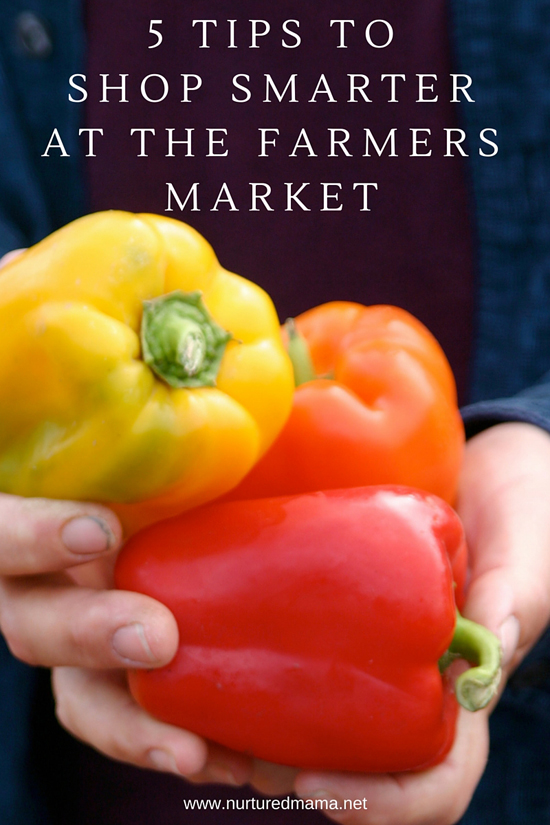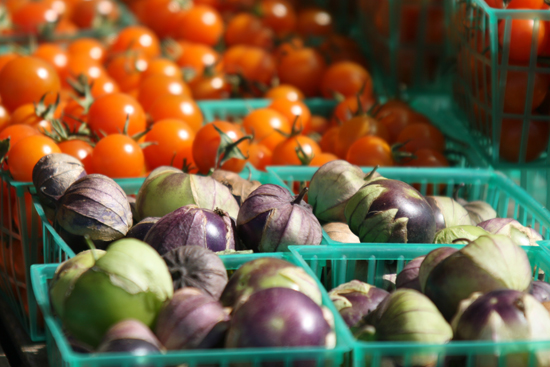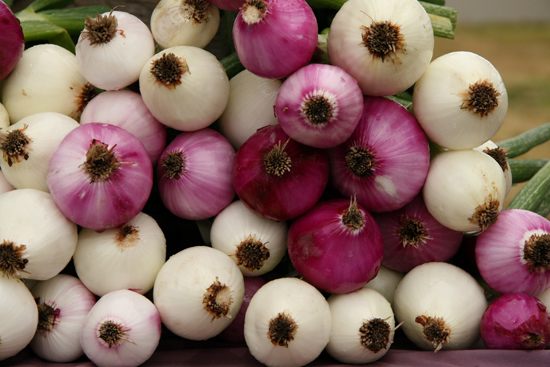5 Tips to Shop Smarter at the Farmers Market
The gorgeous and bustling farmer’s market draws you like a magnet, but as soon as you enter you feel overwhelmed. You have your shopping bag and your small bills, but you realize you have no idea what to buy. What will you cook with this stuff? What even is that vegetable?No need to be overwhelmed! Shop smarter at the farmers market by keeping just a few tips in mind. Note: This post contains affiliate links. If you choose to purchase a product after clicking through a link I will earn few cents from the sale at no additional cost to you. This income helps to support this blog. Thank you!
Note: This post contains affiliate links. If you choose to purchase a product after clicking through a link I will earn few cents from the sale at no additional cost to you. This income helps to support this blog. Thank you!
Make a Plan
Shopping without a list is always dangerous, no matter where you are. You end up with things in your cart you weren’t planning to buy, and then you get home and realize you forgot the one thing you really need for dinner. Shopping without a list at a busy market is just as dangerous. Yet making a list for a seasonal market is a skill that takes some practice. You have to have a sense for what’s in season (see below), and what you’re going to make, as well as knowing how much you need and can reasonably consume in a week.I’m a big advocate of meal planning and I’ve found that doing this consistently in the summer is the best way to actually use all of that beautiful produce from the market. Reduce waste - make a meal plan!
My usual practice is to look at what I have left over from last week and then make a partial meal plan to use up those things. Then I fill in the other days with recipes for things I know are in season and make my market shopping list that way. I also leave myself a little budget for curiosity. Sometimes I’ll see a vegetable I’ve never had before and want to try, or a farmer will suggest something that sounds good but wasn’t in my plan.
5 Cookbooks for Using Market Produce
All of these reside on my shelf and are used often:
- Alice Water’s The Art of Simple Food and The Art of Simple Food II are my recommended place to start with simple, seasonal eating. Her recipes are straightforward and well-written and everything I've made from either of these books has been delicious.
- I like The Farm To Table Cookbook by Ivy Manning because it is arranged by season and she includes detailed introductions to several specific kinds of produce. This book appears to be out of print but is readily available used.
- The CSA Cookbook by Linda Ly is great if you just have a little of this or that, and she’s a fan of using unusual produce, like tomato leaves, nasturtium pods, and the like.
- If you want to take your cooking skills up a notch, Alana Chernilla’s Homemade Kitchen includes great seasonal recipes as well as beginner cheeses, easy fermenting and things you might not think about making at home, like crackers and bagels. Also, the book is just beautiful and makes me want to get in the kitchen immediately.
Know What’s In Season
Eating what’s fresh and in prime season is what I love best about shopping at a farmer’s market. Just-picked strawberries in May are nothing like strawberries in December that have been shipped from Costa Rica or Mexico. A plump heirloom tomato is something you might not even find in a grocery store in any month because they are delicate and easily bruised. Garlic scapes, squash blossoms, and chive flowers are also things you will probably only find at a farm stand.It takes some practice to figure out what's available when if you are used to shopping in a store that carries everything all year. Once you get into a rhythm of visiting a market regularly, you'll start to see the patterns. Delicate stuff comes early in the spring - peas and tulips, mushrooms, and foraged herbs like ramps. In early summer you get leafy vegetables and small root vegetables. Midsummer is the boom of everything that loves heat - corn, tomatoes, peppers, squash, stone fruit. As summer starts to fade you find the big, hardy leafy vegetables and the root veggies that have been growing all summer - onions and garlic. Fall proper will bring the beginning of winter squash, more and more brassicas, and apples and pears. There are certain fruits that once you've eaten them ripe and perfectly in season, fresh from the field, you will be willing to wait all year to eat them that way again.But what’s in season where I live might not be what’s in season where you are. And what grows well in one state may be really rare in another. See if the organization that runs your local market has any information online about grows well and when where you live. My local market association has a weekly newsletter that lists what’s in abundance as well as what’s about to hit the market or just about done. They also include recipes and interviews with local farmers, so it is a terrific resource.Sustainable Table has a site to help you find what’s in season by state.
Know Your Family’s Preferences and Your Cooking Style
Before you get overwhelmed with those long lists of what’s in season, take a step back and consider what your family likes to eat and what you like to cook. Maybe October is all about kale and winter squash, but if your family doesn’t really like either of those things, skip the market those weeks. On the other hand, it can be fun to try new veggies sometimes. You might find new things you like. I discovered that my daughter will eat cauliflower when I buy green, orange or purple heads but will only eat the white kind if I completely douse it with cheese sauce.Or you might discover things you hate. My guy will not eat turnips no matter what ways I’ve tried to cook them, so I’ve just stopped buying them. Our house is a complete no-turnip zone.Likewise, think about how cooking happens in your house. I cook from scratch a lot, and I can go through a lot of produce in a week even with only three of us eating. If you realistically only cook from scratch once or twice a week, or you have staunch no-vegetable eaters, make sure you aren’t buying more than you will use.
Talk With The Farmers
I’m a terrible small-talk-maker, but I make a concerted effort when I’m at the market. I love hearing about how all this food is grown, and also new ideas for how to use it. The folks working in farm stands, usually, are so willing to talk about their wares. Want to see someone in love with their job? Ask a farmer about what’s happening in their fields, what’s great this week, what they recommend. Almost always their face will light up as they talk about it. Don’t be afraid to ask, “What is that? What do I do with it?” They can help you out.The most fascinating conversation I’ve ever had at a market was with the guy selling garlic. I said, “I didn’t know there were so many kinds of garlic!” and he was off. I learned all about hard neck vs. soft neck garlic, heirloom varieties, why some garlic is mild and some is spicy. I haven’t seen him at the market in a long time, and I’m so sad that now I can only find three of four varieties of garlic for sale, because now I know what I’m missing!
Bring the Kids
They say the best way to get kids to eat vegetables is to have them help you cook them (its true, it works), but REALLY the best way to get them involved in eating well is to involve them in shopping and planning, too. Lure them in with the fruit. Who can resist sweet berries or a juicy peach, just perfectly ripe?But I’ll bet they’ll quickly take interest in the whole process, if they begin to understand that this is where food comes from and that these people are growing it, picking it, bringing it to the market to sell. My daughter loves looking in the stalls and asking me about this or that thing she doesn't recognize. She'll try whatever samples are being offered as we wander a market, and has been known to rip off the top of kale leaves that are sticking out of my basket to snack on. I should note that she won’t eat kale at home, cooked or otherwise. She’s recently been fascinated with squash blossoms. Edible flowers? How cool is that?Let your kids lead you, involve them in the conversation about food and where it comes from and why you eat what you do. Be conscious about your food and teach that consciousness to them. They may not seem to hear it all right now, but I promise you from my own experience that it will come back to them later when they are doing their own shopping as adults.
A Few More Ways To Shop Smarter At The Farmers Market
- Bring small bills - many vendors only take cash and may not have change for large bills.
- Bring your own bags. Some vendors don't have produce bags, so be prepared and bring your own from home. These reusable Green Bags will keep your produce fresh for a long time (really!) or ditch the plastic and try cloth bags like these.
- Invest in a nice basket, especially if you are going to load it up. I have one like this.
- Wear sunblock or a hat - don't forget you're outside. I've come home from a market visit more than once with a little burn!
- Slow down and give yourself time to wander. Take in the smells, the beautiful sights, and the happy conversations of other shoppers.
What's your experience with shopping at a farmers market? Do you love or fear them? What is your favorite season or favorite treat? Please share in the comments below.And of course, if you love this article please share it and join the mailing list for more like it.

